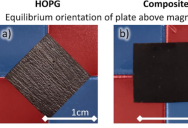Scientists Have Created A Graphite Material That Can Levitate Without Any Energy Being Expended

This isn’t your 1800’s seance levitating, either.
Sometimes, science disappoints us with their claims of futuristic achievements (hoverboards, I’m looking at you).
This levitating material, though, isn’t that.
Researchers from the Quantum Machines Unit at Okinawa Institute of Science and Technology (OIST) showed off the small piece of “gravity-free” graphite.
The material held almost entirely still above a grid of magnets, a fascinating demonstration of magnetic levitation.
The platform does not rely on external power sources, which they say makes it well-suited for the development of a new generation of highly sensitive sensors.

They see both scientific and consumer-level uses for the material.
The floating platform consists of chemically powder-coated graphite beads an a set of magnets they then arrange into a grid pattern.
Other similar systems have required external power sources, as in the past, magnetic levitation can lose energy through “eddy damping.”
Graphite is an extremely powerful electrical conductor, but loses energy when electrical currents flow through it.
These are a few reasons that magnetic levitation has yet to emerge as a way to develop advanced sensors.
Researchers in Japan minimized the amount of movement and are hoping to allow for the development of sensors that can detect changes in gravity on an atomic level.
“Heat causes motion, but by continuously monitoring and providing real-time feedback in the form of corrective actions to the system, we can decrease this movement. The feedback adjusts the system’s damping rate, which is how quickly it loses energy, so by actively controlling the damping, we reduce the system’s kinetic energy, effectively cooling it down.”

As a result, they believe the platform’s performance will shine.
“It could outperform even the most sensitive atomic gravimeters developed to date. These are cutting-edge instruments that use the behavior of atoms to precisely measure gravity.”
Now, they’re building on their research to find ways to cut out even more “external disturbances such as vibrations, magnetic fields, and electrical noise.”
Here’s the future.
Maybe hoverboards that actually hover are next.
If you thought that was interesting, you might like to read a story that reveals Earth’s priciest precious metal isn’t gold or platinum and costs over $10,000 an ounce!

Sign up to get our BEST stories of the week straight to your inbox.




